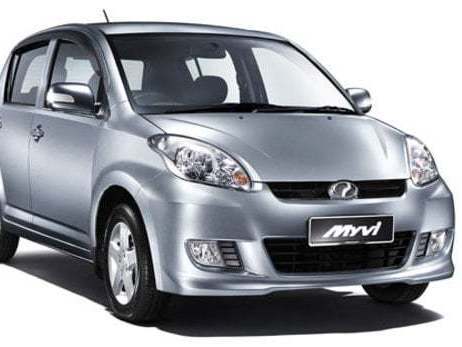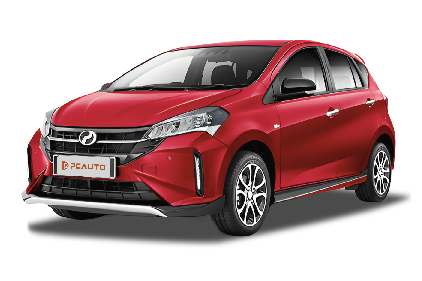Q
what type of car is myvi
The Perodua Myvi is one of Malaysia's most beloved national cars, a staple in the B-segment hatchback category. Manufactured by Perodua, it was first introduced in 2005 and has now reached its third generation. The latest model is equipped with 1.3L and 1.5L DVVT-i naturally aspirated engines, mated to either a 4-speed automatic or a 5-speed manual transmission. It emphasizes economy, practicality, and fuel efficiency, making it an ideal choice for city commuting.
The key to the Myvi's popularity lies in its exceptional value for money. Despite its compact size (3,895mm in length, 1,735mm in width), it offers surprisingly generous headroom and legroom. Furthermore, it comes with features that outperform its class, such as the ASA 3.0 advanced safety system, which includes pre-collision warning and lane departure alert. This has contributed to its long-standing position as a best-seller in the local market.
Notably, the Myvi has a vibrant modification culture in Malaysia. Owners often personalize their cars with sporty suspensions, aftermarket wheels, or body kits. Perodua itself has catered to this trend by launching performance-oriented versions like the GT variant. For buyers considering an affordable commuter car, competitors like the Proton Iriz exist, but the Myvi remains the top choice for many Malaysian families due to its extensive after-sales network and strong resale value.
Special Disclaimer: This content is published by users and does not represent the views or position of PCauto.
Related Q&A
Q
What mileage for MYVI spark plugs?
According to Perodua's official recommendation, the mileage for replacing the spark plugs of the Myvi is usually between 40,000 and 60,000 kilometers. The specific interval depends on the type of spark plugs used in the vehicle and the driving conditions. The original equipment generally comes with ordinary nickel - alloy spark plugs. If you upgrade to iridium or platinum spark plugs, the replacement interval can be extended to 80,000 - 100,000 kilometers.
It's worth noting that if you often experience difficulties with cold starts, unstable idling, or an abnormal increase in fuel consumption, it may be a sign of spark plug aging, and you need to have them checked in advance. The hot and humid climate in Malaysia can accelerate the wear of spark plug electrodes. It is recommended to check the condition of the spark plugs during regular maintenance. At the same time, use original or equivalent - quality accessories that meet the specifications of the Myvi engine (such as the heat range). Inferior spark plugs may lead to a decrease in ignition efficiency and even damage the ignition coil.
For the turbo - charged Myvi X version, since the engine operates at a higher temperature, it is recommended to shorten the replacement cycle by about 20% to ensure optimal performance.
Q
What is the NCAP rating of Perodua Myvi?
The Perodua Myvi has achieved a 5-star rating in the ASEAN NCAP (ASEAN New Car Assessment Programme) tests. This result showcases its excellent performance in terms of safety features. The specific test items include adult occupant protection, child occupant protection, and safety assist systems. The Myvi is equipped with multiple safety features such as dual airbags, an ABS anti - lock braking system, an EBD electronic brake - force distribution system, and a Vehicle Stability Control (VSC) system. All these features have helped it score high in the crash tests.
For Malaysian consumers, choosing a vehicle with a high NCAP rating is very important as it is directly related to the safety guarantee during daily driving. The rating criteria of ASEAN NCAP are similar to those of other NCAP organizations globally, but it pays more attention to the actual road conditions and driving habits in Southeast Asia, thus having greater regional reference value.
Apart from the Myvi, there are also other models from different brands in the Malaysian market that have achieved a 5 - star rating. When purchasing a vehicle, consumers can compare the safety features and test results of different models to ensure they select the vehicle that best suits their needs.
Q
How many spark plugs are in Myvi?
The Perodua Myvi has achieved a 5-star rating in the ASEAN NCAP (ASEAN New Car Assessment Programme) test, which showcases its excellent performance in terms of safety features. The specific test items include adult occupant protection, child occupant protection, and safety assist systems. The Myvi is equipped with multiple safety features such as dual airbags, an ABS anti-lock braking system, an EBD electronic brake-force distribution system, and a Vehicle Stability Control (VSC) system, all of which have earned it high scores in the crash tests.
For Malaysian consumers, choosing a car model with a high NCAP rating is crucial as it directly relates to the safety assurance in daily driving. The rating criteria of ASEAN NCAP are similar to those of other NCAP organizations globally, but it pays more attention to the actual road conditions and driving habits in Southeast Asia, making it more regionally relevant. Besides the Myvi, there are other car models from different brands in the Malaysian market that have also received a 5-star rating. When purchasing a car, consumers can compare the safety features and test results of different models to ensure they select the vehicle that best suits their needs.
Q
Is myvi a reliable car?
The Myvi is a reliable car. Judging from its sales performance, the Myvi has been the best - selling car model in Malaysia from 2005 to 2014. As of now, its cumulative sales have reached 1,491,765 units. In 2024, it remains the best - selling hatchback in Malaysia and is very popular among consumers. In terms of product characteristics, it offers high cost - effectiveness. The price ranges from RM 46,500 to RM 59,900, and it comes with a rich set of features. It has low fuel consumption, being equipped with a 1.3L or 1.5L Dual VVT - i engine, and the official minimum fuel consumption is 4.5L per 100km. In terms of space, as a B - class hatchback, it has reasonable body dimensions. The rear seats can be folded down, making it highly practical. In terms of safety, the current model is equipped with advanced safety features such as Perodua Smart Drive Assist (PSDA). So, whether it's the market's recognition or its own characteristics, they all indicate that the Myvi is a reliable car.
Q
How much is myvi fuel consumption?
As one of the most popular national cars in Malaysia, the fuel economy of the Perodua Myvi varies depending on the model and driving conditions. According to official data, the fuel consumption of the latest Myvi in mixed conditions is about 5.3 to 5.6 liters per 100 kilometers (for the 1.5L engine version), which means it can travel about 18 to 19 kilometers per liter of gasoline. The 1.3L engine version may be even more fuel - efficient. The actual performance is affected by driving habits, road conditions, and the vehicle's maintenance status. For example, frequent rapid acceleration or driving in congested urban areas can significantly increase fuel consumption.
It is recommended that car owners regularly check the tire pressure, replace the air filter, and use the recommended engine oil to optimize fuel economy. Additionally, the Myvi has a fuel tank capacity of 36 liters, and theoretically, it can have a cruising range of about 600 kilometers when the tank is full.
For car owners who want to save more fuel, they can try some economical driving techniques such as smooth acceleration and anticipating road conditions to reduce sudden braking. These methods are applicable to all fuel - powered vehicles, which can not only reduce the cost of using the car but also reduce mechanical wear.
Q
How many Litres is a MYVI fuel tank?
The fuel tank capacity of the Perodua Myvi varies slightly depending on the model. The first - generation Myvi (2005 - 2011) had a fuel tank capacity of 40 liters. For the second - generation (2011 - 2017) and third - generation (2017 to present) Myvi, the fuel tank capacity increased to 36 liters for the 1.3L models and 40 liters for the 1.5L models. This design is to balance the fuel - economy requirements of different engine displacements. Malaysian car owners should note that the fuel tank capacity directly affects the driving range. Usually, a 1.5L model can travel about 500 - 600 kilometers on a full tank under combined driving conditions, which specifically depends on driving habits and road conditions. It is recommended that car owners regularly check the fuel system and maintain good driving habits to optimize fuel consumption. Meanwhile, it should be noted that the Myvi only needs to use RON95 gasoline and there's no need to use higher - grade fuel. This can not only meet the daily commuting needs but also save fuel costs.
Q
How many cylinders are in the MYVI?
As one of the most popular national cars in Malaysia, the engine configurations of the Perodua Myvi vary according to different years and versions. Currently, the mainstream models are equipped with two types of Dual VVT - i four - cylinder naturally aspirated engines, namely the 1.3L (1NR - VE) and 1.5L (2NR - VE). Therefore, all Myvi models feature a four - cylinder design. This four - cylinder layout ensures smooth power delivery while taking fuel economy into account, making it highly suitable for the urban road conditions in Malaysia.
It's worth mentioning that four - cylinder engines, due to their simple structure and low maintenance costs, are widely used in B - segment models in the local market. For example, the Proton Saga and Honda City also adopt a similar layout. The 1.5L version of the Myvi can output 102 horsepower and 136 Nm of torque. Coupled with its lightweight body design, it can offer a well - balanced performance whether driving on the congested streets of Kuala Lumpur or cruising on the highway.
For readers who want to learn about engine technology, they can note that the Dual VVT - i system used in the Myvi can intelligently adjust the valve timing. This technology shared by Toyota helps to improve fuel efficiency by about 15%. That's why the Myvi has remained one of the most fuel - efficient cars in Malaysia for years.
Q
Are Myvi and vios the same engine?
Some models of the Myvi and the Vios use the same engine. Daihatsu and Perodua have a joint - venture engine production plant in Negeri Sembilan, Malaysia, which provides power for multiple models including the Vios. Some models of the Vios and the Myvi are equipped with the 1.5L Dual VVT - i engine. This engine features high efficiency, reliability, and economy. Although its power is not extremely strong (the official 0 - 100km/h acceleration time of the Myvi 1.5 is 10.2 seconds), its low fuel consumption and durability are well - loved by consumers. However, these two cars have different positioning and market targets. Even if they share the engine platform, there are differences in vehicle tuning, configuration, and the overall driving experience.
Q
What kind of gearbox is Myvi?
The Myvi is equipped with a Dual Mode CVT (D-CVT) transmission, which is a dual-mode continuously variable transmission. Compared with traditional CVT transmissions, it has an additional gear for high-speed driving, which helps the vehicle achieve better fuel efficiency.
In daily driving, this transmission drives the vehicle in CVT mode. Thanks to the operation of the steel belt, the vehicle moves smoothly and linearly, enhancing comfort. What makes the D-CVT special is that it automatically switches to the gear mode when driving at high speeds. Different from CVT transmissions of other brands, when driving at high speeds, the engine speed of vehicles with ordinary CVT transmissions will increase, the engine noise will get louder, and the fuel consumption will rise. Moreover, the power will decline after exceeding the maximum horsepower speed. However, after the gear of the D-CVT engages, the engine speed decreases, allowing the engine to maintain a reasonable speed and providing the vehicle with continuous and abundant power.
Q
Does Myvi use CVT?
Yes, the Perodua Myvi does use CVT (Continuously Variable Transmission) technology in some models, especially the newer ones. For instance, the third-generation Myvi, launched in 2017, and its subsequent versions are equipped with D-CVT (Dual Mode Continuously Variable Transmission) to offer a smoother driving experience and better fuel efficiency. CVT technology optimizes engine performance through continuously variable gear ratios. Compared with traditional automatic transmissions, it can adapt to driving conditions more flexibly, thereby enhancing overall driving comfort. However, earlier Myvi models may have used a traditional 4-speed automatic transmission. So, whether a specific model is equipped with a CVT needs to be confirmed based on the model year and configuration. For Malaysian consumers, the advantages of CVT lie in its smoothness and fuel - saving performance during city driving, which is very suitable for the common local traffic conditions. But if you're looking for more direct power feedback, some drivers may prefer the manual transmission version. If you're considering buying a Myvi, it's recommended to check the official specifications or consult a dealer to confirm the transmission type. You can also take a test drive to see if the actual performance of the CVT meets your driving preferences.
Popular Cars
Model Year
Car Compare
Car Photo
Latest Q&A
Q
Is a 3.0 liter engine a V6?
A 3.0-liter engine doesn’t always mean a V6 configuration—though V6 is indeed the most common layout for this displacement. The actual engine type depends on the vehicle’s design. For example, some BMW models use an inline-six, while certain Porsches feature a flat-six, both in 3.0-liter form. Even some V8s can achieve a 3.0-liter working volume with cylinder deactivation.
The relationship between displacement and cylinder count boils down to individual cylinder capacity and layout. A typical 3.0L V6 averages around 500cc per cylinder, striking a balance between power delivery and smoothness.
Worth noting: Turbocharging has blurred the lines—smaller engines (like high-output 2.0T units) now match the power of naturally aspirated 3.0Ls. When evaluating engines, don’t just fixate on displacement or cylinder count. Factor in tech like direct injection and variable valve timing—brands tune even identical displacements differently. Some prioritize low-end torque for city driving, while others favor high-revving performance for highway cruising.
Q
What is the difference between a 2.4 L and a 3.0 L engine?
The key difference between 2.4L and 3.0L engines boils down to displacement. The 3.0L's larger cylinder volume means it gulps more air and fuel per combustion cycle, delivering roughly 20-30% more horsepower and torque than the 2.4L – perfect for drivers who prioritize acceleration or towing capability.
That said, the 2.4L shines in fuel efficiency, especially for city driving. Both engines might pack modern tech like variable valve timing or direct injection, but 3.0L variants often get extra performance goodies—think twin-scroll turbos or high-pressure fuel systems.
Just remember: bigger displacement typically means higher road taxes and running costs. Many models offer both options, so choose based on your needs—whether it's power or pocket-friendly mileage.
Q
Is the 3.5 EcoBoost a V6 or V8?
Ford's 3.5L EcoBoost is a twin-turbocharged V6 engine—not a V8 configuration. It combines direct injection and turbocharging tech to deliver near-V8 power from a more compact six-cylinder package. Typical versions punch out around 375 horsepower and 475 Nm of torque, commonly found in F-150 pickups and Explorers. The real win here is balancing performance with decent fuel efficiency.
The core difference between V6 and V8 layouts boils down to cylinder count and refinement—V8s traditionally offer smoother power delivery and higher peak output, but at the cost of added weight and thirst. Modern turbo V6s like this EcoBoost have narrowed that gap significantly. It’s Ford’s poster child for giving buyers the best of both worlds: robust towing capability without the daily-driver penalties of a bulkier V8. If you want American muscle without guzzling fuel or wrestling with a ponderous rig around town, these force-fed six-cylinders hit the sweet spot.
Q
What does 2.4 L I4 mean?
The 2.4L I4 refers to a 2.4-liter displacement engine with an inline-four cylinder layout—a common configuration found in many vehicles. The 2.4L displacement means the total volume of all cylinders adds up to 2.4 liters, and generally, a larger displacement delivers stronger power output, making it suitable for performance-oriented driving. The inline-four design is popular for its compact size and fuel efficiency, striking a good balance between smoothness and noise control while keeping maintenance costs reasonable for daily use. Some models may even pair this engine with turbocharging for extra power and efficiency. If you prioritize fuel economy and reliability without sacrificing everyday usability, the 2.4L I4 is a solid choice, whether for city commutes or long-distance trips.
Q
Which engine is better, V6 or V8?
V6 and V8 engines each have their pros and cons—it really comes down to your needs and how you plan to use them. A V6 is generally lighter, more fuel-efficient, and easier on the wallet for maintenance, making it a solid pick for daily commuting or city driving. On the other hand, a V8 delivers more power and smoother performance, ideal for high-performance cars or heavy towing, though it guzzles more fuel and costs more to maintain.
In hot, rainy climates, V6s tend to handle heat better, while V8s offer more stability at high speeds. These days, turbocharged V6s are closing the performance gap with traditional V8s, though V8s still dominate in luxury and sports models.
Whichever you choose, sticking to regular maintenance and using the right oil viscosity is key to keeping your engine healthy. Just weigh your driving habits and budget—there’s no one-size-fits-all answer.
View MoreRelated News

Donald Trump praised Malaysia's adorable little car, Perodua Myvi received acclaim
LienDec 9, 2025

Since Its Launch in 2005, the Perodua Myvi has Cumulatively Sold Over 1,559,000 Units in 20 Years
WilliamMay 13, 2025

Perodua Myvi : A Value Choice for Worry-Free Car Purchases
LienMar 25, 2025

Own Perodua Myvi for less than RM 60,000: The best choice for city commuting?
LienOct 16, 2024

Perodua Traz 2025:Spec, Price and Features
AshleyDec 22, 2025
View More


















Pros
Cons